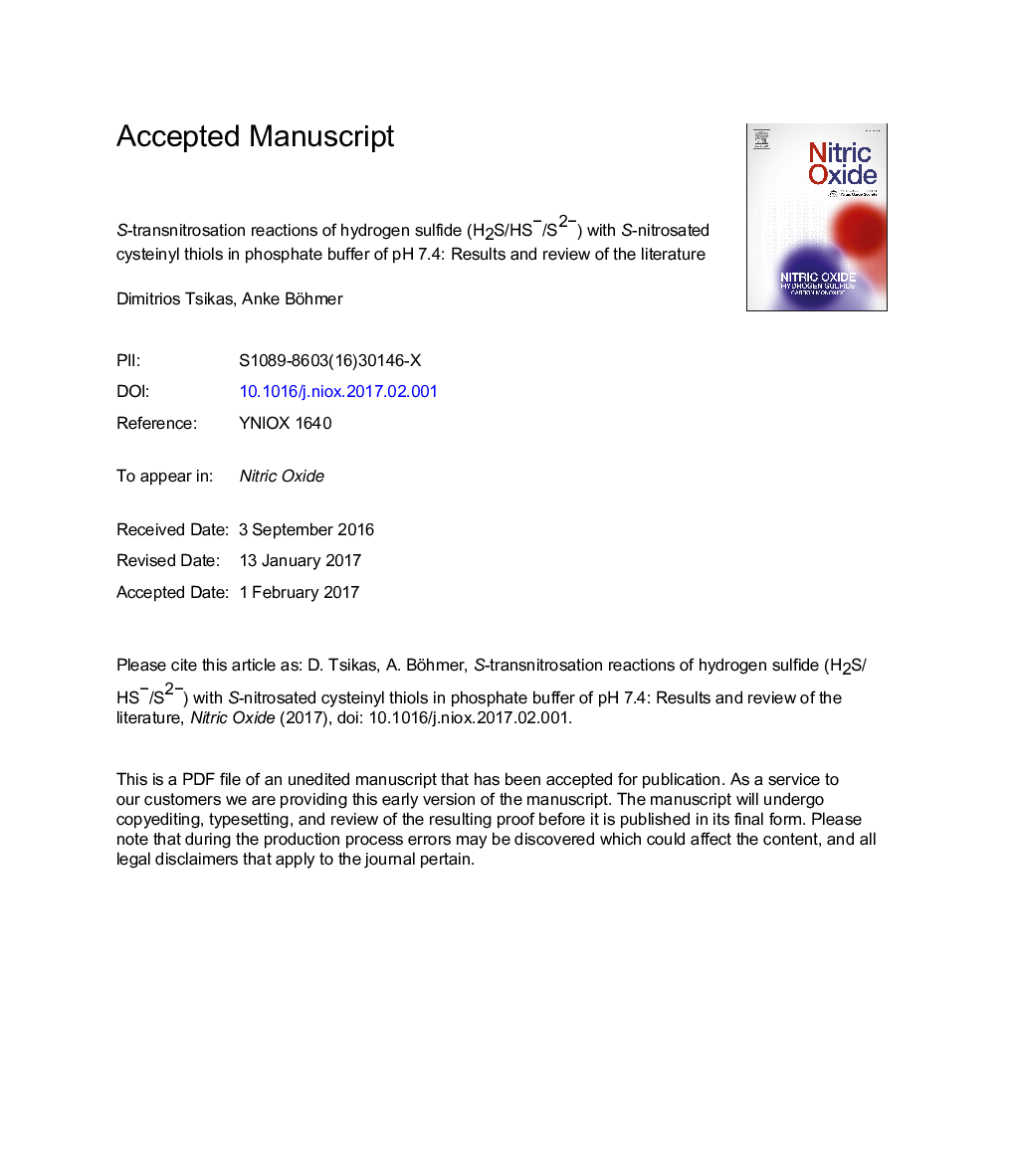| کد مقاله | کد نشریه | سال انتشار | مقاله انگلیسی | نسخه تمام متن |
|---|---|---|---|---|
| 5514273 | 1541595 | 2017 | 51 صفحه PDF | دانلود رایگان |
عنوان انگلیسی مقاله ISI
S-Transnitrosation reactions of hydrogen sulfide (H2S/HSâ/S2â) with S-nitrosated cysteinyl thiols in phosphate buffer of pH 7.4: Results and review of the literature
دانلود مقاله + سفارش ترجمه
دانلود مقاله ISI انگلیسی
رایگان برای ایرانیان
کلمات کلیدی
موضوعات مرتبط
علوم زیستی و بیوفناوری
بیوشیمی، ژنتیک و زیست شناسی مولکولی
زیست شیمی
پیش نمایش صفحه اول مقاله

چکیده انگلیسی
Cysteine (CysSH) and its derivatives including N-acetylcysteine (NAC) and glutathione (GSH), and cysteine residues in proteins and enzymes are nitrosated with nitric oxide (NO) reaction products such as N2O3 to form S-nitrosated cysteine thiols (RCysSNO). RCysSNO undergo with cysteine thiols (RCysSH) S-transnitrosation reactions, thereby transferring reversibly their nitrosyl (+NO) group to RCysSH to form RCysSNO.
- NO release from RCysSNO and S-transnitrosation are considered the most important features and signalling pathways of RCysSNO. Hydrogen sulfide (H2S: pKa1, 7; HSâ: pKa2, 12.9) is an endogenous product of cysteine metabolism. We hypothesized that RCysSNO would also undergo S-transnitrosation reaction with H2S/HSâ/S2â to form thionitrite (ONSâ), the smallest S-nitrosated thiol. This article describes spectrophotometric and mass spectrometric investigations of S-transnitrosation reactions in phosphate buffered saline (PBS) of pH 7.4 between H2S/HSâ/S2â (supplied as Na2S) and S-nitrosoglutathione (GSNO), S-nitroso-l-cysteine (CysSNO), S-nitroso-N-acetyl-l-cysteine (SNAC), and the synthetic S-nitroso-N-acetyl-l-cysteine ethyl ester (SNACET). For comparison, we also investigated the reactions of H2S/HSâ/S2â with NO+BF4â and NO2+BF4â, direct ON+ and O2N+ donors, respectively, and assumed formation of ONSâ and thionitrate (O2NSâ), respectively. Addition of Na2S (at 1 mM) to buffered RCysSNO solutions resulted in decreases of the absorbance at 340 nm and concomitant increases in the absorbance at 410 nm depending upon the nature and concentration of RCysSNO (range, 25-1000 μM). The reactivity order of RCysSNO against H2S/HSâ/S2â was: CysSNO > SNACET > GSNO > SNAC. Our spectrophotometric and GC-MS analyses indicate that H2S/HSâ/S2â and RCysSNO undergo multiple reactions. Major final reaction products were found to be nitrite and nitrate. ONSâ and O2NSâ were not detected by GC-MS, suggesting rapid and complete S/O-exchange from water at pH 7.4. GC-MS analyses of ethyl acetate extracts of reaction mixtures suggested formation of tetrasulfur (S4), the precursor of elemental sulfur (S8). The broad absorbance around 410 nm and the turbidity occurred in RCysSNO/Na2S reaction mixtures support formation of polysulfides (polysulfanes) and colloidal sulfur. The reaction of NO+BF4â and NO2+BF4â with H2S/HSâ/S2â differed from the S-transnitrosation reactions of RCysSNO, with NO+BF4â being more reactive than NO2+BF4â. In this article, we also briefly review and discuss recent published work dealing with the reaction of H2S/HSâ/S2â with low- and high-molecular-mass S-nitrosated thiols. This research area is highly challenging and controversial with respect to the primarily formed reaction products. The synthesis of structurally well-characterized, pure stable-isotope labelled species of putative reaction products, including ONSâ, O2NSâ and ONSSâ, and their use in combination with mass spectrometry coupled to chromatography, e.g. GC-MS and LC-MS/MS, are indispensable in exploring the complex interaction of the two gasotransmitters, H2S and
- NO.
- NO release from RCysSNO and S-transnitrosation are considered the most important features and signalling pathways of RCysSNO. Hydrogen sulfide (H2S: pKa1, 7; HSâ: pKa2, 12.9) is an endogenous product of cysteine metabolism. We hypothesized that RCysSNO would also undergo S-transnitrosation reaction with H2S/HSâ/S2â to form thionitrite (ONSâ), the smallest S-nitrosated thiol. This article describes spectrophotometric and mass spectrometric investigations of S-transnitrosation reactions in phosphate buffered saline (PBS) of pH 7.4 between H2S/HSâ/S2â (supplied as Na2S) and S-nitrosoglutathione (GSNO), S-nitroso-l-cysteine (CysSNO), S-nitroso-N-acetyl-l-cysteine (SNAC), and the synthetic S-nitroso-N-acetyl-l-cysteine ethyl ester (SNACET). For comparison, we also investigated the reactions of H2S/HSâ/S2â with NO+BF4â and NO2+BF4â, direct ON+ and O2N+ donors, respectively, and assumed formation of ONSâ and thionitrate (O2NSâ), respectively. Addition of Na2S (at 1 mM) to buffered RCysSNO solutions resulted in decreases of the absorbance at 340 nm and concomitant increases in the absorbance at 410 nm depending upon the nature and concentration of RCysSNO (range, 25-1000 μM). The reactivity order of RCysSNO against H2S/HSâ/S2â was: CysSNO > SNACET > GSNO > SNAC. Our spectrophotometric and GC-MS analyses indicate that H2S/HSâ/S2â and RCysSNO undergo multiple reactions. Major final reaction products were found to be nitrite and nitrate. ONSâ and O2NSâ were not detected by GC-MS, suggesting rapid and complete S/O-exchange from water at pH 7.4. GC-MS analyses of ethyl acetate extracts of reaction mixtures suggested formation of tetrasulfur (S4), the precursor of elemental sulfur (S8). The broad absorbance around 410 nm and the turbidity occurred in RCysSNO/Na2S reaction mixtures support formation of polysulfides (polysulfanes) and colloidal sulfur. The reaction of NO+BF4â and NO2+BF4â with H2S/HSâ/S2â differed from the S-transnitrosation reactions of RCysSNO, with NO+BF4â being more reactive than NO2+BF4â. In this article, we also briefly review and discuss recent published work dealing with the reaction of H2S/HSâ/S2â with low- and high-molecular-mass S-nitrosated thiols. This research area is highly challenging and controversial with respect to the primarily formed reaction products. The synthesis of structurally well-characterized, pure stable-isotope labelled species of putative reaction products, including ONSâ, O2NSâ and ONSSâ, and their use in combination with mass spectrometry coupled to chromatography, e.g. GC-MS and LC-MS/MS, are indispensable in exploring the complex interaction of the two gasotransmitters, H2S and
- NO.
ناشر
Database: Elsevier - ScienceDirect (ساینس دایرکت)
Journal: Nitric Oxide - Volume 65, 1 May 2017, Pages 22-36
Journal: Nitric Oxide - Volume 65, 1 May 2017, Pages 22-36
نویسندگان
Dimitrios Tsikas, Anke Böhmer,